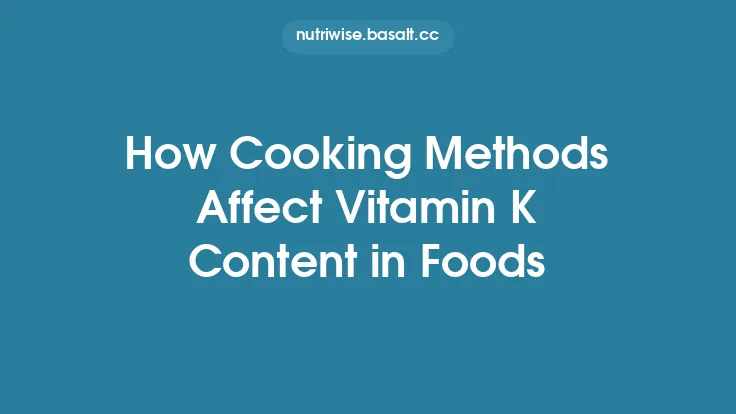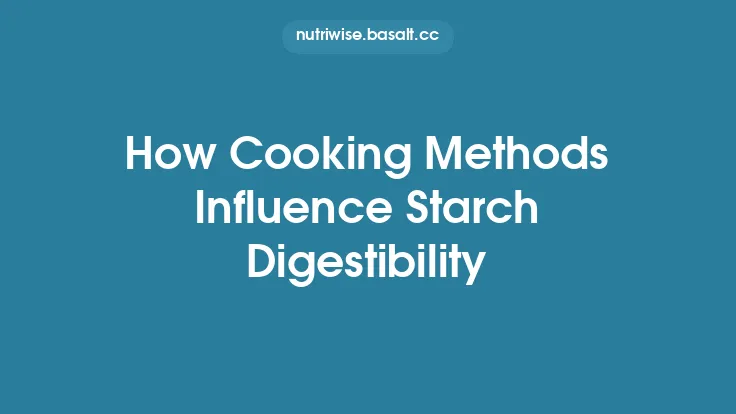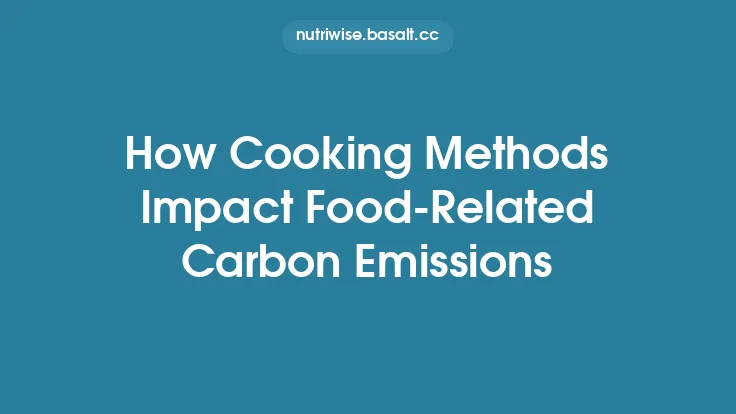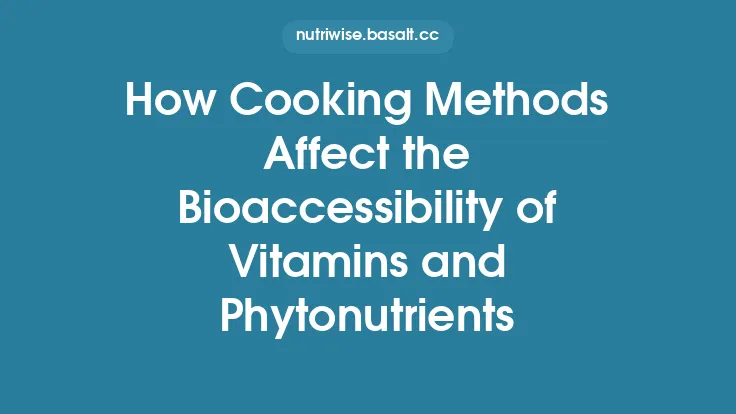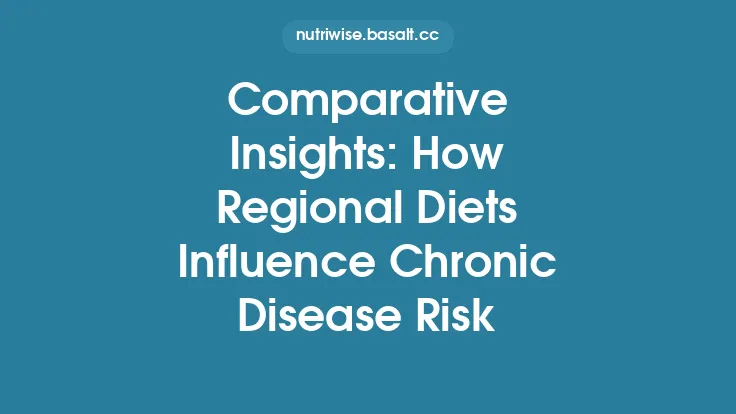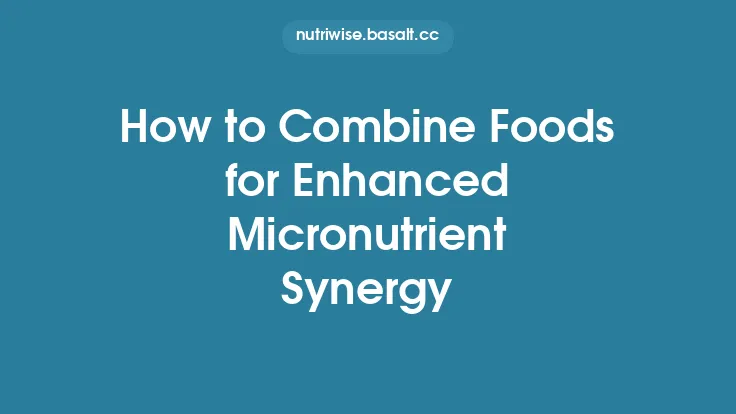Cooking is one of the most universal ways we transform raw foods into meals that are safe, palatable, and digestible. Yet the heat, moisture, and mechanical forces applied during cooking also act on the micronutrients—vitamins, minerals, and phytonutrients—present in those foods. Understanding how different cooking methods alter the chemical form, stability, and matrix interactions of micronutrients is essential for anyone who wants to preserve the nutritional quality of their diet over the long term.
Below is a comprehensive examination of the principal cooking techniques and the mechanisms by which they influence micronutrient availability. The discussion is organized by nutrient class (water‑soluble vitamins, fat‑soluble vitamins, minerals, and selected phytochemicals) and then by cooking method, allowing readers to see both the broad patterns and the nutrient‑specific nuances.
1. Heat‑Induced Chemical Transformations
1.1. Thermal Degradation
Many vitamins are inherently heat‑labile. The rate of degradation follows first‑order kinetics and is accelerated by higher temperatures, longer exposure times, and the presence of oxygen. For example, vitamin C (ascorbic acid) undergoes oxidation to dehydroascorbic acid, which can further break down into diketogulonic acid, a non‑functional form. Thiamine (vitamin B1) is similarly sensitive, especially in alkaline environments.
1.2. Maillard Reactions and Vitamin Loss
The Maillard reaction, a non‑enzymatic browning process between reducing sugars and amino acids, becomes prominent at temperatures above 120 °C. While it contributes desirable flavor and color, it can also trap certain B‑vitamins within melanoidin polymers, reducing their extractability and bioaccessibility.
1.3. Oxidative Enzyme Inactivation
Cooking inactivates endogenous enzymes such as polyphenol oxidase and lipoxygenase. This can be beneficial for preserving certain micronutrients (e.g., preventing enzymatic oxidation of carotenoids) but may also halt beneficial enzymatic conversions, such as the activation of glucosinolates to isothiocyanates in cruciferous vegetables.
2. Water‑Based Cooking Methods
2.1. Boiling
Boiling immerses food in water at 100 °C. The primary impact on micronutrients is leaching: water‑soluble vitamins (C, B‑complex) and minerals (potassium, magnesium) diffuse from the food matrix into the cooking water. The extent of loss depends on surface area, cut size, and cooking duration. Studies consistently show that 30 minutes of boiling can remove 30–50 % of vitamin C from leafy greens.
*Mitigating factor*: If the cooking liquid is retained (e.g., in soups or stews), the leached nutrients remain part of the meal, albeit in a different matrix.
2.2. Steaming
Steaming exposes food to saturated steam at 100 °C while keeping it physically separated from water. Because the food does not sit in liquid, leaching is minimal. Micronutrient retention is markedly higher than boiling: vitamin C losses typically fall below 15 % for most vegetables, and mineral losses are negligible. The gentle heat also preserves cell wall integrity, facilitating later digestion and absorption.
2.3. Simmering and Poaching
These low‑temperature water‑based methods (80–90 °C) are gentler than boiling. They reduce oxidative degradation of heat‑sensitive vitamins while still allowing some leaching. Poaching delicate proteins (e.g., fish) often retains more B‑vitamins than pan‑frying because the temperature never exceeds 85 °C.
2.4. Blanching
A brief exposure to boiling water (1–3 minutes) followed by rapid cooling in ice water is used to inactivate enzymes before freezing or canning. Blanching causes modest losses of water‑soluble vitamins (5–15 %) but is essential for preserving color and texture during storage. The short duration limits both leaching and thermal degradation.
3. Fat‑Based Cooking Methods
3.1. Sautéing and Stir‑Frying
These high‑heat, short‑duration techniques (150–200 °C) involve a thin layer of oil. Fat‑soluble vitamins (A, D, E, K) are protected from oxidation because they dissolve in the cooking oil, which acts as a barrier to oxygen. Moreover, the presence of lipid enhances the micellar solubilization of carotenoids and tocopherols, improving their subsequent absorption in the intestine.
However, the high temperature can degrade heat‑sensitive carotenoids (e.g., β‑carotene) if cooking exceeds 10 minutes. The rapid cooking time typical of stir‑frying usually limits this loss, making it one of the most efficient methods for extracting lipophilic micronutrients.
3.2. Deep‑Frying
Immersing food in oil at 175–190 °C for extended periods can cause oxidative breakdown of polyunsaturated fatty acids, generating lipid peroxides that may react with adjacent vitamins. Vitamin E, a primary lipid‑soluble antioxidant, is particularly vulnerable, with losses up to 30 % reported after 15 minutes of deep‑frying. Conversely, the oil can solubilize and retain fat‑soluble vitamins that would otherwise be lost in water‑based cooking.
3.3. Baking and Roasting (Dry‑Heat with Fat)
When foods are baked or roasted with added oil, the same protective effect for fat‑soluble vitamins applies. The dry heat (180–220 °C) can cause Maillard browning, which may entrap some B‑vitamins, but the overall retention of vitamins A and E is generally high, especially when cooking times are limited to 30–45 minutes.
4. High‑Pressure and Low‑Temperature Techniques
4.1. Pressure Cooking
Pressure cookers raise the boiling point of water to 115–120 °C under elevated pressure, dramatically reducing cooking time. The shortened exposure limits thermal degradation of heat‑sensitive vitamins, while the sealed environment minimizes oxygen exposure. Studies show that pressure cooking can retain up to 80 % of vitamin C in carrots, compared with 40 % after conventional boiling.
Mineral leaching still occurs, but because the cooking liquid is usually consumed (e.g., in stews), the net loss from the diet is minimal.
4.2. Sous‑Vide (Vacuum‑Sealed Low‑Temperature Cooking)
Sous‑vide involves sealing food in a plastic pouch and cooking it in a water bath at precisely controlled temperatures (55–85 °C) for extended periods (1–24 hours). The absence of oxygen and the low temperature preserve both water‑ and fat‑soluble vitamins exceptionally well. For instance, vitamin C losses in sous‑vide‑cooked broccoli are often below 10 %, while β‑carotene retention can exceed 90 %.
The vacuum environment also prevents moisture loss, maintaining the food’s natural matrix and reducing leaching.
5. Micronutrient‑Specific Responses to Cooking
5.1. Vitamin C (Ascorbic Acid)
- Most vulnerable to heat, oxygen, and water leaching.
- Best retained by steaming, microwaving (short bursts), and sous‑vide.
- Greatly reduced by prolonged boiling or deep‑frying.
5.2. B‑Complex Vitamins
- Thiamine (B1): Sensitive to alkaline pH and high heat; best preserved by steaming and pressure cooking.
- Riboflavin (B2): More stable; moderate losses in boiling, minimal in steaming.
- Niacin (B3): Relatively heat‑stable; minor losses across methods.
- Folate (B9): Highly water‑soluble and heat‑labile; steaming and microwaving retain >80 % whereas boiling can lose >50 %.
5.3. Vitamin A and Carotenoids
- β‑Carotene, lutein, lycopene: Fat‑soluble; cooking with a small amount of oil dramatically improves their bioaccessibility by breaking down cell walls and forming micelles.
- Heat effect: Moderate heat (100–150 °C) can isomerize lycopene from the trans to the cis form, which is more readily absorbed. Excessive heat (>200 °C) can degrade them.
5.4. Vitamin D, E, K
- Highly lipophilic; stable under most cooking conditions unless exposed to prolonged high temperatures and oxidative environments (e.g., deep‑frying).
- Retention: >90 % in steaming, sautéing, and baking; slight reductions in deep‑frying due to oxidation.
5.5. Minerals (Calcium, Iron, Zinc, Magnesium, Potassium)
- Generally heat‑stable; losses are primarily due to leaching into cooking water.
- Retention: High when cooking liquids are consumed (e.g., soups, gravies). Boiling without liquid retention leads to 10–30 % losses for potassium and magnesium.
- Phytate interaction: While not the focus of this article, it is worth noting that cooking methods that reduce phytate content (e.g., soaking, fermentation) indirectly improve mineral bioavailability.
5.6. Polyphenols and Flavonoids
- Heat can both liberate and degrade. For example, chlorogenic acid in coffee beans is released during roasting, whereas catechins in green tea degrade with prolonged heating.
- Cooking with oil (e.g., sautéing onions) can increase the extractability of certain flavonoids by disrupting cell membranes.
6. The Role of Cooking Vessel and Environment
6.1. Material Influence
- Stainless steel and enamel: Inert, do not interact with micronutrients.
- Cast iron: Can leach iron into acidic foods, modestly increasing iron content.
- Aluminum: May bind phosphates, potentially reducing phosphorus bioavailability; however, the effect is minor in typical home cooking.
6.2. Closed vs. Open Systems
- Closed systems (pressure cookers, sous‑vide) limit oxygen exposure, reducing oxidative loss of vitamins C and E.
- Open systems (boiling in uncovered pots) allow volatile compounds (e.g., some B‑vitamins) to escape with steam.
7. Practical Implications for Meal Planning
While the article’s primary aim is to delineate the scientific mechanisms, the following take‑aways can guide long‑term dietary strategies:
- Match the nutrient to the method: Use steaming or microwaving for vitamin C‑rich vegetables; employ a modest amount of oil and a quick sauté for carotenoid‑rich produce.
- Preserve cooking liquids: When boiling or pressure cooking, incorporate the broth into sauces, soups, or gravies to reclaim leached water‑soluble vitamins and minerals.
- Control temperature and time: Short, high‑heat bursts (stir‑frying) often outperform long, low‑heat simmering for preserving both water‑ and fat‑soluble micronutrients.
- Consider the food matrix: Whole foods retain more micronutrients than pre‑cut or pre‑processed pieces because the intact cellular structure slows diffusion of nutrients into cooking water.
- Utilize modern techniques: Sous‑vide and pressure cooking provide excellent retention for a broad spectrum of micronutrients while also delivering desirable texture and flavor.
8. Summary of Key Findings
| Cooking Method | Vitamin C | B‑Complex | Fat‑Soluble Vitamins (A, D, E, K) | Minerals | Notable Mechanisms |
|---|---|---|---|---|---|
| Boiling (water) | 30–50 % loss | 20–40 % loss (leaching) | Minimal loss | 10–30 % loss (leaching) | Leaching, oxidation |
| Steaming | ≤15 % loss | ≤10 % loss | ≤5 % loss | ≤5 % loss | Minimal leaching, limited oxidation |
| Microwaving (short) | ≤20 % loss | ≤15 % loss | ≤5 % loss | ≤5 % loss | Rapid heating, limited water contact |
| Sautéing (oil) | ≤20 % loss | ≤15 % loss | ≤5 % loss (enhanced absorption) | ≤5 % loss | Lipid solubilization, limited water loss |
| Deep‑Frying | 30–40 % loss | 20–30 % loss | 10–30 % loss (oxidation) | ≤10 % loss | Oxidative environment, high temperature |
| Pressure Cooking | ≤20 % loss | ≤15 % loss | ≤5 % loss | ≤10 % loss | Short time, sealed environment |
| Sous‑Vide | ≤10 % loss | ≤10 % loss | ≤5 % loss | ≤5 % loss | Low temperature, vacuum, no oxygen |
| Roasting (dry, with oil) | 20–30 % loss | 15–25 % loss | ≤5 % loss | ≤10 % loss | Maillard reactions, limited leaching |
These data illustrate that the combination of temperature, moisture, and exposure to oxygen dictates the fate of each micronutrient during cooking. By selecting the appropriate method for a given food and nutrient profile, it is possible to preserve—or even enhance—the bioavailability of essential vitamins and minerals without sacrificing culinary quality.
